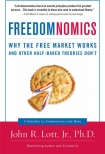Freedomnomics: Why the Free Market Works and Other Half-Baked Theories Don't John Jr. (the dot read aloud .txt) 📖

- Author: John Jr.
Book online «Freedomnomics: Why the Free Market Works and Other Half-Baked Theories Don't John Jr. (the dot read aloud .txt) 📖». Author John Jr.
Even a venerable government institution such as NASA is not above engaging in predation. For many years, one of the greatest obstacles to the private sector in space was the competition it faced from NASA’s below-cost pricing of space-shuttle flights.53 It may seem strange that NASA would charge private companies so little to launch their satellites into space. After all, a private company that enjoyed a near-monopoly like NASA does would typically charge high, monopoly prices for such a service. But, as a government-owned firm, NASA is not primarily interested in profits. To the contrary, it historically has charged below-cost prices in order to prevent private companies from competing in the market. NASA may not show a lot of concern for profits, but it likes to keep its near-monopoly on American shuttle launches, which sustains the agency’s prestige.
Interestingly, the U.S. government has accused the Chinese government’s space program of engaging in predation and even forced that program to change its pricing policies before it would allow U.S. firms to use Chinese satellite launch services.54 Despite the propensity of U.S. government agencies to engage in predation themselves, these kinds of accusations against foreigners are not rare. In fact, the U.S. government accuses foreign government-run institutions of predatory practices even more frequently than it levels accusations against privately owned firms.
Predation often proves easy for government-owned companies because they benefit directly from the act of predation itself. A private predator suffers badly when it slashes prices below cost, even as sales rise. But this is not the case with a public firm that values sales and employment over profits. In fact, predation is so harmful to private companies that they don’t actually want to do it; they are only really successful if they can scare away potential competitors through the threat of predation. If the threat is credible, then a firm doesn’t actually have to follow through with it. But who is more likely to make a convincing bluff? A private company, which is geared toward maximizing profits and would lose a lot of money during a predation campaign? Or a public firm, which is not so concerned by lost profits, and which would actually benefit from predation by expanding output or market share? The evidence indicates that predation rarely occurs by private companies.55 Government predation, however, is very easy to find.56
The Modern Guild System
State intervention in the economy can take many forms other than direct government spending or the operation of state-owned companies. For example, the government establishes all kinds of regulations that govern private business. These rules are often presented as necessary measures to make the market more “fair.” But a close look at one major type of regulation—state licensing of professionals—reveals how some of these laws not only hinder free competition, but are deliberately designed to do so.
Licensing of professionals is a practice that has existed for a very long time. For instance, Medieval European guilds made young apprentices work for years—sometimes over a decade—at low pay before they were allowed to practice their craft on their own.57 If a skilled worker didn’t go through the official training, he wasn’t allowed to practice the craft. Looking at similar guild practices during his own day, Adam Smith, the father of economics, concluded that guilds existed largely to restrict the number of people entering a profession in order to keep wages high.58
This was already the case during the Middle Ages. Medieval guilds did not exist primarily to guarantee product quality, as guild leaders argued. Such guarantees were only really useful in cases where a product’s quality was difficult to evaluate before purchasing it, such as medicine. But the longest apprenticeships were in professions in which it was easy to immediately judge the quality of the product. For example, in thirteenth-century Paris, apprenticeships lasted ten years for making iron buckles, tables, and buttons, while in Genoa it took eleven years to be certified as a chest maker. Rigidly enforced guild statutes dictated the length of Parisian apprenticeships, their pay (rarely any), and whether meals and lodging were included. These rules were partly designed to keep masters from enticing away each other’s apprentices by offering better conditions—in other words, they aimed to hinder the creation of a free market in labor.59
The same dynamics are perpetuated today in many state-run programs for licensing professionals. To become a licensed professional, states typically require a person to fulfill various education requirements mandated by professional associations. But are these requirements really necessary? Why can’t an aspiring professional get a license simply by passing a rigorous licensing test with practical components? If a student spends years educating himself and then aces his bar exam, is he really less qualified to be a lawyer than someone who studied in law school classes? He may not be, but a self-educated lawyer would be barred from the profession nonetheless—aspiring lawyers are required to spend two-and-a-half years in school. Oftentimes ambitious students are even prohibited from taking a heavier course load and finishing early.
Onerous education requirements exist for many other professions. For example, most states require optometry students to study at an accredited school for at least six terms of eight months each before they can take either the national or state certification exams.60 Likewise, medical students must receive at least three-and-a-half years of schooling. 61 Medical schools, like law schools, lose their accreditation if they





Comments (0)